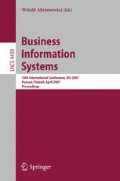Abstract
This paper presents an enterprise–modelling oriented approach to IT Governance. Main requirements for a IT Governance Framework are presented and applicability is shown by means of operationalizing Strategic Alignment — a main focus area of IT Governance. Two frameworks are briefly described, namely PRO2SA (domain-specific for Strategic Business Alignment) and the general–purpose framework SQUAM for metamodelling, enterprise modelling and model-analysis. Key aspects of this approach are the information enrichment of enterprise models (mainly with key figures) and the integration into a Business Intelligence Suite for comprehensive business analysis.
Access this chapter
Tax calculation will be finalised at checkout
Purchases are for personal use only
Preview
Unable to display preview. Download preview PDF.
References
Buchta, D., Eul, M., Schulte-Croonenberg, H.: Strategisches IT-Management — Wert steigern, Leistung steuern, Kosten senken. Gabler, Wiesbaden (2004)
Zarnekow, R., Brenner, W., Grohmann, H.H.H.: Informationsmanagement — Konzepte und Strategien für die Praxis. dpunkt, Heidelberg (2004)
Weill, P., Ross, J.W.: IT-Governance, 1st edn. Harvard Business School Press, Boston (2004)
Carr, N.G.: It doesn’t matter. Harvard Business Review 81(5), 41–49 (2003)
Stewart, T.A.: Does it matter? An HBR debate. Harvard Business Review (Web Exclusive), 1–17 (June 2003)
Brynjolfsson, E., Hitt, L.M.: Beyond productivity paradox; computers are the catalyst for bigger changes. Communications of the ACM 41(8), 49–55 (1998)
Brynjolfsson, E.: The it productivity gap: roi valuation. Optimize (21) (July 2003)
Piller, F.T.: Das Produktivitätsparadoxon der Informationstechnologie aus betriebswirtschaftlicher Sicht. Wirtschaftspolitische Blätter (Kommentar und Ergänzungen zum Diskussionsschwerpunkt der Wirtschaftspolitischen Blätter) 1 (1998)
Rau, S.E., Bye, B.S.: Are you getting value from your it? Journal of Business Strategy, 16–20 (May/June 2003)
ISACA: Optimising value creation of it-investments. Technical report, ISACA-Organisation, IT-Governance-Institute (2005)
ISACA: Measuring and demonstrating the value of it. Technical report, ISACA-Organisation, IT-Governance-Institute (2005)
ITGI: IT Control Objectives for Sarbanes-Oxley - The role of IT in design and implementation of internal control over financial reporting, 2nd edn. IT-Governance Institute (2006)
Gartner: Growing it’s contribution: The 2006 cio agenda (2006)
PricewaterhouseCoopers: It governance global status report - 2006. Technical report, IT Governance Institute (2006)
Webb, P., Pollard, C.E., Ridley, G.: Attempting to define it governance: Wisdom or folly? In: HICSS, IEEE Computer Society Press, Los Alamitos (2006)
Simonsson, M., Hultgren, E.: Administrative systems and operation support systems - a comparison of IT governance maturity. In: Proceedings of the CIGRÉ International Colloquium on Telecommunications and Informatics for the Power Industry (June 2005)
ISACA: Cobit 4. PDF (11 2005)
Van Grembergen, W.: Introduction to the minitrack ”it governance and its mechanisms”. In: HICSS 2004, Proceedings of the 37th Annual Hawaii International Conference on System Sciences, 5-8 Jan. 2004, pp. 231–231 (2004)
ISACA: Board briefing on it governance. Book (2003)
GSE: It-governance. Technical report, Guide Share Europe (2004)
Tilg, B.: Anforderungen an ein modellbasiertes Strategic Business Alignment der Informationstechnologie. In: Cremers, A.B., et al. (eds.) GI Jahrestagung (2). LNI, vol. 68, pp. 506–510. GI (2005)
Simonsson, M., Johnson, P.: Defining IT governance - a consolidation of literature. Technical report, Royal Institute of Technology (KTH) (November 2005)
Henderson, J.C., Venkatraman, N.: Strategic alignment: Leveraging information technology for transforming organizations. IBM Systems Journal 32(1), 4–16 (1993)
Henderson, J.C., Venkatraman, N., Oldach, S.: Aligning Business and IT Strategies. In: Luftman, J.N. (ed.) Competing in the Information Age: Strategic Alignment in Practice, p. 21. Oxford University Press, Oxford (1996)
Luftman, J.N.: Competing in the Information Age: Strategic Alignment in Practice. Oxford University Press, Oxford (1996)
Avison, D., et al.: Using and validating the strategic alignment model. Journal of Strategic Information Systems 13, 223–246 (2004)
Tilg, B., Breu, R.: Pro2sa — ein modellgetriebener Ansatz zur Integration des Strategic Business Alignments in die Business Intelligence. In: Lehner, F., Nösekabel, H., Kleinschmidt, P. (eds.) GI Jahrestagung (2), pp. 97–109. GITO (2006)
Tilg, B., Hechenblaikner, C., Breu, R.: Integration der Open Business Intelligence-Suite Pentaho in ein modellgetriebenes Analyse-Framework am Beispiel des Strategic Alignments. In: Schelp, J., et al. (eds.) Integration, Informationslogistik und Architektur, Proceedings DW2006. LNI, vol. P-90, pp. 125–140. Gesellschaft für Informatik (2006)
Stahl, T., Völter, M.: Modellgetriebene Softwareentwicklung: Techniken, Engineering, Management, 1st edn. dpunkt.verlag, Heidelberg (2005)
Chimiak-Opoka, J., et al.: Tool–supported systematic model assessment. In: Vol. P–82 of Lecture Notes in Informatics (LNI), pp. 183–192. Gesellschaft fuer Informatik (2006)
Kaplan, R.S., Norton, D.P.: The balanced scorecard — measures that drive performance. Harvard Business Review, 71–79 (January-February 1992)
Matthes, F., Wittenburg, A.: Softwarekartographie: Visualisierung von anwendungslandschaften und ihrer schnittstellen. In: GI Jahrestagung (2), pp. 71–75 (2004)
Chimiak-Opoka, J., et al.: Tool–Supported Systematic Model Assessment. In: Mayr, H., Breu, R. (eds.) Modellierung 2006, Innsbruck, Tirol, Austria. Lecture Notes in Informatics (LNI), vol. 82, pp. 183–192. Gesellschaft fuer Informatik (2006), http://conf.ifit.uni-klu.ac.at/mod2006/
OMG.: Meta-Object Facility (MOF)—Specification of version 2.0 (Jan. (2006), http://www.omg.org/technology/documents/formal/MOF_Core.htm
Chimiak-Opoka, J., Lenz, C.: Use of OCL in a Model Assessment Framework, http://st.inf.tu-dresden.de/OCLApps2006/topic/acceptedPapers/15_Opoka_ModelAssessmentFramework.pdf . Number TUD-FI06-04-Sept. 2006, Genova (Oct. 2006), http://st.inf.tu-dresden.de/OCLApps2006/ OCLApps workshop co-located with http://modelsconference.org/ MoDELS 2006: 9th International Conference on Model-Driven Engineering Languages and Systems (formerly the UML series of conferences)
Warmer, J., Kleppe, A.G.: The Object Constraint Language—Precise Modeling with UML, 1st edn (1999)
Inmon, W.H.: Building the data warehouse, 4th edn. John Wiley & Sons, New York (2005)
Gamma, E., et al.: Entwurfsmuster. Addison-Wesley, Reading (1995)
Breu, R., Chimiak-Opoka, J.: Towards Systematic Model Assessment. In: Akoka, J., et al. (eds.) ER Workshops 2005. LNCS, vol. 3770, pp. 398–409. Springer, Heidelberg (2005)
Author information
Authors and Affiliations
Editor information
Rights and permissions
Copyright information
© 2007 Springer Berlin Heidelberg
About this paper
Cite this paper
Tilg, B., Chimiak-Opoka, J., Lenz, C., Breu, R. (2007). Towards Operationalizing Strategic Alignment of IT by Usage of Software Engineering Methods. In: Abramowicz, W. (eds) Business Information Systems. BIS 2007. Lecture Notes in Computer Science, vol 4439. Springer, Berlin, Heidelberg. https://doi.org/10.1007/978-3-540-72035-5_48
Download citation
DOI: https://doi.org/10.1007/978-3-540-72035-5_48
Publisher Name: Springer, Berlin, Heidelberg
Print ISBN: 978-3-540-72034-8
Online ISBN: 978-3-540-72035-5
eBook Packages: Computer ScienceComputer Science (R0)

